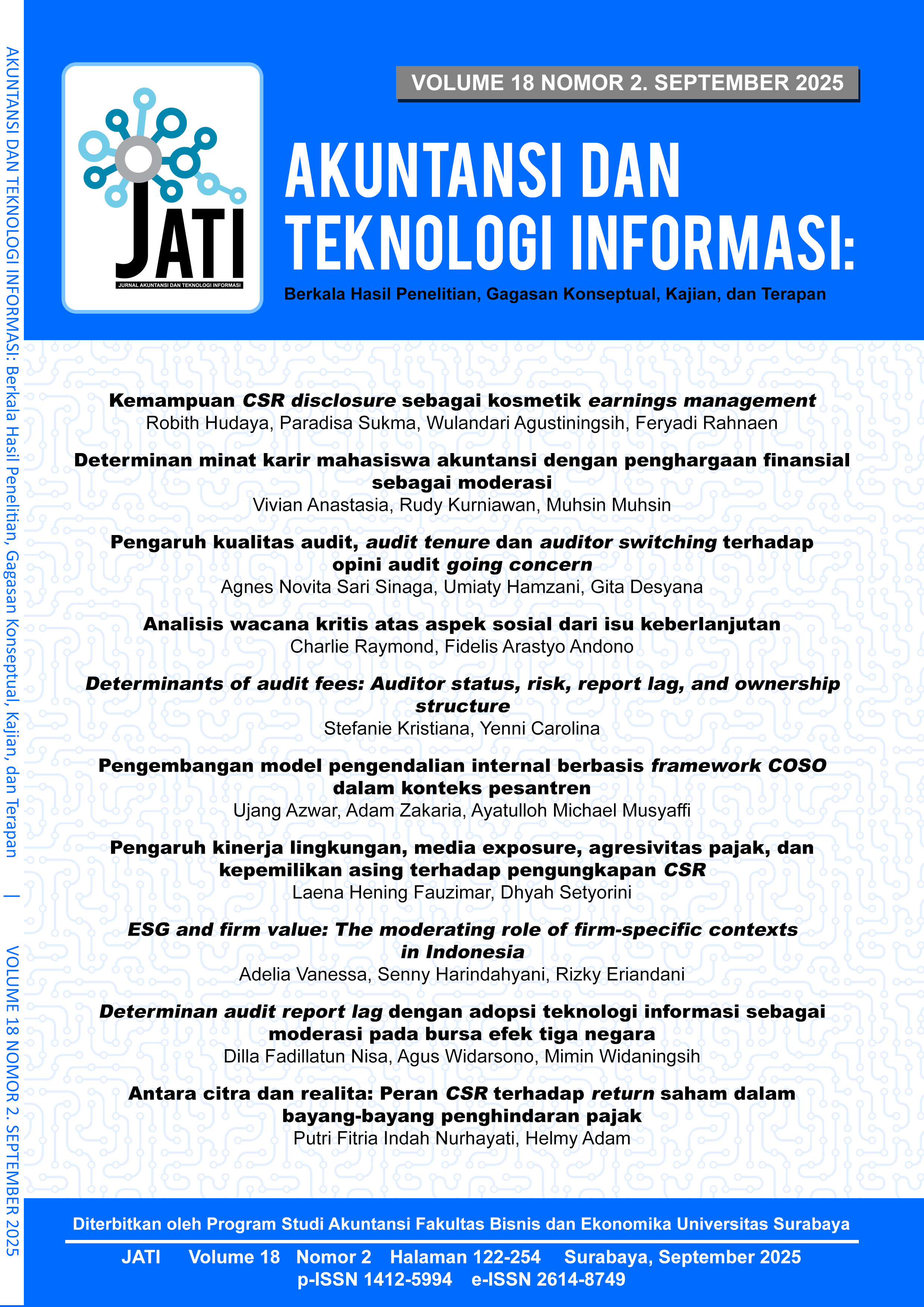ESG and firm value: The moderating role of firm-specific contexts in Indonesia
 Abstract Views:
224 times
Abstract Views:
224 times
 PDF Downloads:
56 times
PDF Downloads:
56 times
Abstract
Purpose – This study aims to examine the impact of environmental, social, and governance (ESG) performance on firm market value, while incorporating firm-specific contexts such as downside risk and upside potential as moderating variables.
Methods – A quantitative approach was employed, using data from firms listed on the Indonesia Stock Exchange during 2018–2022 that had ESG scores from S&P Global Ratings. A total of 176 firm years were selected and analyzed using moderated regression analysis.
Findings - The results reveal a negative relationship between ESG performance and firm value. However, financial risk and environmental risk significantly mitigate the negative impact of ESG on firm value, while financial stability and sales growth do not moderate the relationship. These findings emphasize that investors in emerging markets perceive ESG differently than those in developed economies.
Implications - This research provides theoretical implications by enriching the literature on investor responses to ESG in developing countries, and practical insights for managers and investors in using ESG as a risk management tool..
Originality - Unlike prior studies in developed markets that highlight ESG’s positive role, this study shows that Indonesian investors tend to view ESG negatively unless it serves as an effective risk-reduction mechanism, highlighting the importance of firm-specific contexts.
Downloads
References
Adiputri, D. A. P. K., & Wati, N. W. A. E. (2021). Pengaruh Profitabilits, Likuiditas Dan Capital Intensity Terhadap Agresivitas Pajak. Hita Akuntansi Dan Keuangan, 2(2), 467–487. https://doi.org/10.32795/hak.v2i2.1567
Albuquerque, R., Koskinen, Y., & Zhang, C. (2019). Corporate Social Responsibility and Firm Risk: Theory and Empirical Evidence. Management Science, 65(10), 4451–4469. https://doi.org/10.1287/mnsc.2018.3043
Badrinath, S. G., Gay, G. D., & Kale, J. R. (1989). Patterns of Institutional Investment, Prudence, and the Managerial “Safety-Net” Hypothesis. The Journal of Risk and Insurance, 56(4), 605. https://doi.org/10.2307/253449
Bardos, K. S., Ertugrul, M., & Gao, L. S. (2020). Corporate social responsibility, product market perception, and firm value. Journal of Corporate Finance, 62, 101588. https://doi.org/10.1016/j.jcorpfin.2020.101588
Bocquet, R., Le Bas, C., Mothe, C., & Poussing, N. (2017). CSR, Innovation, and Firm Performance in Sluggish Growth Contexts: A Firm-Level Empirical Analysis. Journal of Business Ethics, 146(1), 241–254. https://doi.org/10.1007/s10551-015-2959-8
Boehe, D. M., & Cruz, B. L. (2010). Corporate Social Responsibility, Product Differentiation Strategy and Export Performance. Journal of Business Ethics, 91(S2), 325–346. https://doi.org/10.1007/s10551-010-0613-z
Brealey, R. A., Myers, S. C., & Allen, F. (2014). Principles of corporate finance. McGraw-Hill Irwin,.
Buchanan, B., Cao, C. X., & Chen, C. (2018). Corporate social responsibility, firm value, and influential institutional ownership. Journal of Corporate Finance, 52, 73–95. https://doi.org/10.1016/j.jcorpfin.2018.07.004
Cheng, B., Ioannou, I., & Serafeim, G. (2014). Corporate social responsibility and access to finance. Strategic Management Journal, 35(1), 1–23. https://doi.org/10.1002/smj.2131
Ciftci, I., Tatoglu, E., Wood, G., Demirbag, M., & Zaim, S. (2019). Corporate governance and firm performance in emerging markets: Evidence from Turkey. International Business Review, 28(1), 90–103. https://doi.org/https://doi.org/10.1016/j.ibusrev.2018.08.004
Dezsö, C. L., & Ross, D. G. (2012). Does female representation in top management improve firm performance? A panel data investigation. Strategic Management Journal, 33(9), 1072–1089. https://doi.org/10.1002/smj.1955
Dhananjaya, K. (2023). Market valuation and corporate investment in India. Vilakshan - XIMB Journal of Management, 20(1), 42–58. https://doi.org/10.1108/XJM-01-2021-0022
Eriandani, R., & Winarno, W. A. (2023). ESG and firm performance: The role of digitalization. Journal of Accounting and Investment, 24(3), 993–1010. https://doi.org/10.18196/jai.v24i3.20044
Flammer, C. (2018). Competing for government procurement contracts: The role of corporate social responsibility. Strategic Management Journal, 39(5), 1299–1324. https://doi.org/10.1002/smj.2767
Flammer, C., & Luo, J. (2017). Corporate social responsibility as an employee governance tool: Evidence from a quasi‐experiment. Strategic Management Journal, 38(2), 163–183. https://doi.org/10.1002/smj.2492
Freeman, R. E. (1984). Strategic management: A stakeholder approach. Cambridge university press.
Friede, G., Busch, T., & Bassen, A. (2015). ESG and financial performance: aggregated evidence from more than 2000 empirical studies. Journal of Sustainable Finance & Investment, 5(4), 210–233. https://doi.org/10.1080/20430795.2015.1118917
Garcia, A. S., & Orsato, R. J. (2020). Testing the institutional difference hypothesis: A study about environmental, social, governance, and financial performance. Business Strategy and the Environment, 29(8), 3261–3272. https://doi.org/10.1002/bse.2570
Godfrey, P. C., Merrill, C. B., & Hansen, J. M. (2009). The relationship between corporate social responsibility and shareholder value: an empirical test of the risk management hypothesis. Strategic Management Journal, 30(4), 425–445. https://doi.org/10.1002/smj.750
Hackston, D., & Milne, M. J. (1996). Some determinants of social and environmental disclosures in New Zealand companies. Accounting, Auditing & Accountability Journal, 9(1), 77–108. https://doi.org/10.1108/09513579610109987
Himawan, F. A., & Karjono, Al. (2019). Analisis Pengaruh Financial Stability, Ineffective Monitoring dan Rationalization Terhadap Integritas Laporan Keuangan dalam Perspektif Fraud Triangle Pada Perusahaan Manufaktur yang Terdapat di Bursa Efek Indonesia Periode 2012-2016. Jurnal Manajemen Bisnis, 22(2), 162–188.
Husnaini, W., Sasanti, E. E., & Cahyaningtyas, S. R. (2018). Corporate Social Responsibility (CSR) dan Reputasi Perusahaan. Jurnal Aplikasi Akuntansi, 2(2), 1–9. https://doi.org/10.29303/jaa.v2i2.22
Jain, R. (2007). Institutional and individual investor preferences for dividends and share repurchases. Journal of Economics and Business, 59(5), 406–429. https://doi.org/10.1016/j.jeconbus.2007.04.004
Kim, J. Y., & Keane, A. (2024). Corporate social responsibility and performance in the workplace: a meta-analysis. International Journal for Educational and Vocational Guidance, 24(3), 781–807. https://doi.org/10.1007/s10775-023-09581-3
Lins, K. V, Servaes, H., & Tamayo, A. (2017). Social capital, trust, and firm performance: The value of corporate social responsibility during the financial crisis. The Journal of Finance, 72(4), 1785–1824. https://doi.org/10.1111/jofi.12505
Lu, H., Oh, W.-Y., Kleffner, A., & Chang, Y. K. (2021). How do investors value corporate social responsibility? Market valuation and the firm specific contexts. Journal of Business Research, 125, 14–25. https://doi.org/10.1016/j.jbusres.2020.11.063
Marsat, S., & Williams, B. (2013). CSR and market valuation: International evidence. Bankers Markets & Investors: An Academic & Professional Review, 123, 29–42. https://doi.org.10.2139/ssrn.1833581
Masulis, R. W., & Reza, S. W. (2015). Agency Problems of Corporate Philanthropy. Review of Financial Studies, 28(2), 592–636. https://doi.org/10.1093/rfs/hhu082
McWilliams, A., & Siegel, D. (2001). Corporate Social Responsibility: a Theory of the Firm Perspective. Academy of Management Review, 26(1), 117–127. https://doi.org/10.5465/amr.2001.4011987
Oikonomou, I., Brooks, C., & Pavelin, S. (2012). The Impact of Corporate Social Performance on Financial Risk and Utility: A Longitudinal Analysis. Financial Management, 41(2), 483–515. https://doi.org/10.1111/j.1755-053X.2012.01190.x
Orlitzky, M., Siegel, D. S., & Waldman, D. A. (2011). Strategic Corporate Social Responsibility and Environmental Sustainability. Business & Society, 50(1), 6–27. https://doi.org/10.1177/0007650310394323
Polii, Y., & Herawaty, V. (2020). Pengaruh Profitabilias, Pembagian Dividen, Kebijakan Csr, Dan Kepemilikan Asing Terhdap Nilai Perusahaan Dengan Stabilitas Keuangan Sebagai Variabel Moderasi (Study Empiris Perusahaan Property, Real-Estate, Dan Construction Yang Terdaftar Di Bei Tahun 201. Jurnal Penelitian Dan Karya Ilmiah Lembaga Penelitian Universitas Trisakti, 5(2), 79–98. https://doi.org/10.25105/pdk.v5i2.7363
Price, J. M., & Sun, W. (2017). Doing good and doing bad: The impact of corporate social responsibility and irresponsibility on firm performance. Journal of Business Research, 80, 82–97. https://doi.org/10.1016/j.jbusres.2017.07.007
PwC. (2022). PwC ’ s global investor survey 2022: The ESG execution gap. 6. http://www.pwc.com/GIS2022
Saeidi, S. P., Sofian, S., Saeidi, P., Saeidi, S. P., & Saaeidi, S. A. (2015). How does corporate social responsibility contribute to firm financial performance? The mediating role of competitive advantage, reputation, and customer satisfaction. Journal of Business Research, 68(2), 341–350. https://doi.org/10.1016/j.jbusres.2014.06.024
Sharfman, M. P., & Fernando, C. S. (2008). Environmental risk management and the cost of capital. Strategic Management Journal, 29(6), 569–592. https://doi.org/10.1002/smj.678
Sheikh, N. A., & Wang, Z. (2011). Determinants of capital structure. Managerial Finance, 37(2), 117–133. https://doi.org/10.1108/03074351111103668
Shiu, Y., & Yang, S. (2017). Does engagement in corporate social responsibility provide strategic insurance‐like effects? Strategic Management Journal, 38(2), 455–470. https://doi.org/10.1002/smj.2494
Wang, T., & Bansal, P. (2012). Social responsibility in new ventures: profiting from a long‐term orientation. Strategic Management Journal, 33(10), 1135–1153. https://doi.org/10.1002/smj.1962

This work is licensed under a Creative Commons Attribution-ShareAlike 4.0 International License.
- Copyright on articles is retained by the respective author(s), without restrictions. A non-exclusive license is granted to Akuntansi dan Teknologi Informasi (JATI) to publish the article and identify itself as its original publisher, along with the commercial right to include the article in a hardcopy issue for sale to libraries and individuals.
- Articles published in Akuntansi dan Teknologi Informasi (JATI) are licensed under a Creative Commons Attribution-ShareAlike 4.0 International license. You are free to copy, transform, or redistribute articles for any lawful purpose in any medium, provided you give appropriate credit to the original author(s) and the journal, link to the license, indicate if changes were made, and redistribute any derivative work under the same license.
- By publishing in Akuntansi dan Teknologi Informasi (JATI), authors grant any third party the right to use their article to the extent provided by the Creative Commons Attribution-ShareAlike 4.0 International license.

 DOI:
DOI:









